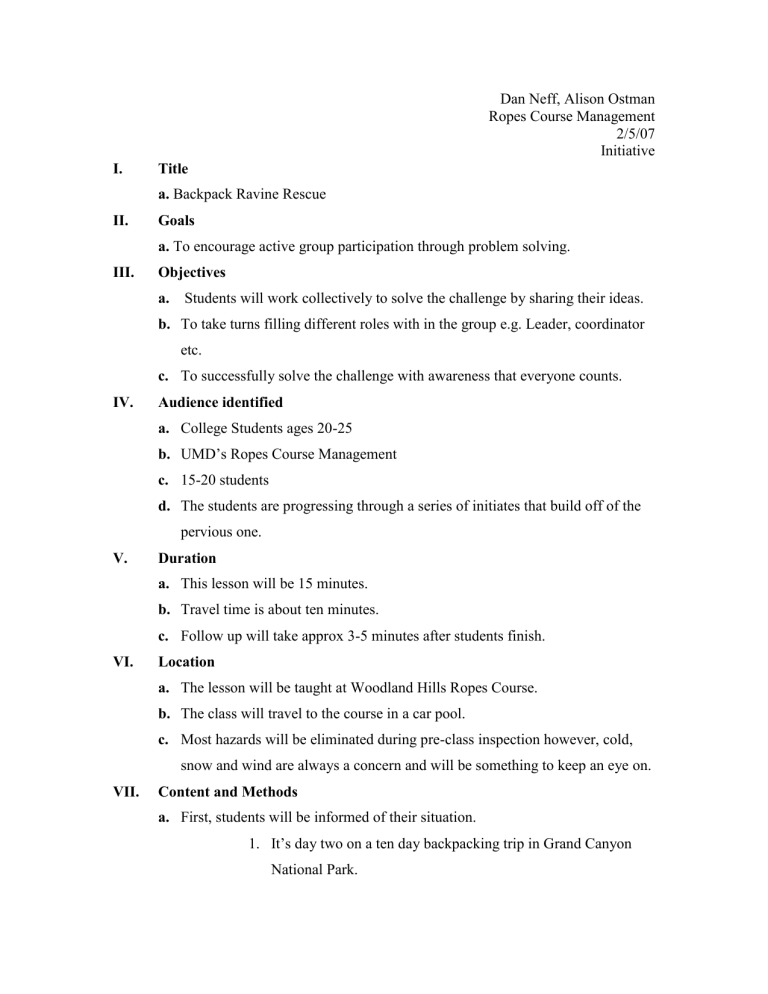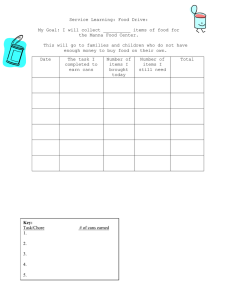Backpack Ravine

Dan Neff, Alison Ostman
Ropes Course Management
2/5/07
Initiative
I.
Title a. Backpack Ravine Rescue
II.
Goals a. To encourage active group participation through problem solving.
III.
Objectives a.
Students will work collectively to solve the challenge by sharing their ideas.
b.
To take turns filling different roles with in the group e.g. Leader, coordinator etc.
c.
To successfully solve the challenge with awareness that everyone counts.
IV.
Audience identified a.
College Students ages 20-25 b.
UMD’s Ropes Course Management c.
15-20 students d.
The students are progressing through a series of initiates that build off of the pervious one.
V.
Duration a.
This lesson will be 15 minutes.
b.
Travel time is about ten minutes.
c.
Follow up will take approx 3-5 minutes after students finish.
VI.
Location a.
The lesson will be taught at Woodland Hills Ropes Course.
b.
The class will travel to the course in a car pool.
c.
Most hazards will be eliminated during pre-class inspection however, cold, snow and wind are always a concern and will be something to keep an eye on.
VII.
Content and Methods a.
First, students will be informed of their situation.
1.
It’s day two on a ten day backpacking trip in Grand Canyon
National Park.
2.
While transferring your gear across a ravine, the rope breaks and you watch helplessly as your food pack plunges 25 feet into the ravine.
3.
Luckily your group is prepared with a handy-dandy retrieving tool (the bike tire with ropes) b.
Next, lay out the guidelines for the challenge.
1.
Students may not cross over the boundary line as this is the edge of the ravine.
2.
To simulate spilled gear, students must stack small cans into large can before removing it.
3.
Ask students to be thinking about the roles they and others in the group are taking as well making sure everyone counts.
c.
Begin the challenge
1.
Watch for risk management issues – cold body language, hazardous behavior and inappropriate negative communication.
2.
As outdoor education students, participants may find this activity not so challenging. If the group completes the activity with ease, add another challenge.
3.
Place treats in small cans and require that students empty the small cans into the large one before removing it.
4.
Conclude with treats to show everyone counts.
VIII.
Management and Safety a.
As stated above, the site will be inspected by instructors as well as participants during pre-class inspection.
b.
Watch for cold body language as well as exclusion. Manage for positive reward; not negative consequences.
IX.
Equipment a.
1 large and 1 medium coffee cans, 1 soup can and one tuna can.
b.
1 handy-dandy retrieving tool (bike tire with ropes tied on) c.
Treats
X.
Weather alternative
a.
Give the lesson on an alternate date or inside if a facility is available
XI.
Evaluation a.
What challenges were faced?
b.
What techniques and methods of communication worked well?
c.
What didn’t work well?
d.
What roles emerged with in the group?
XII.
Follow up a.
Follow up will come the following Tuesday with another initiative which builds off of the concepts in this one.
XIII.
Reference materials to support your lesson a.
Rohnke, K. (1996) Quicksilver: Adventure Games, Initiative Problems, Trust
Activities and a Guide to Effective Leadership. Kendall Hunt Publishing
Company


